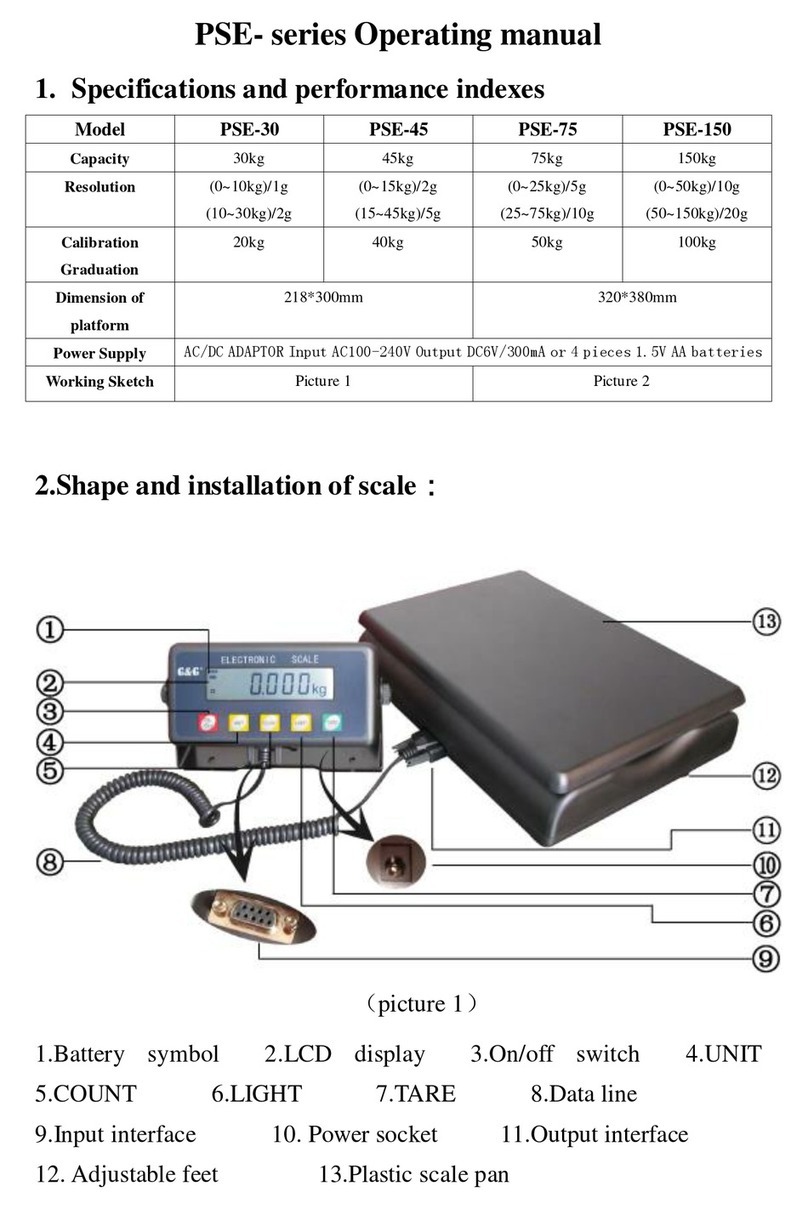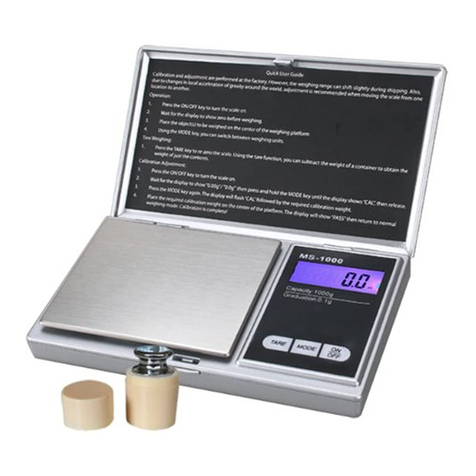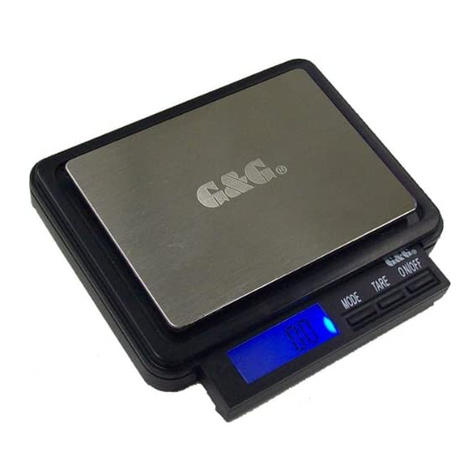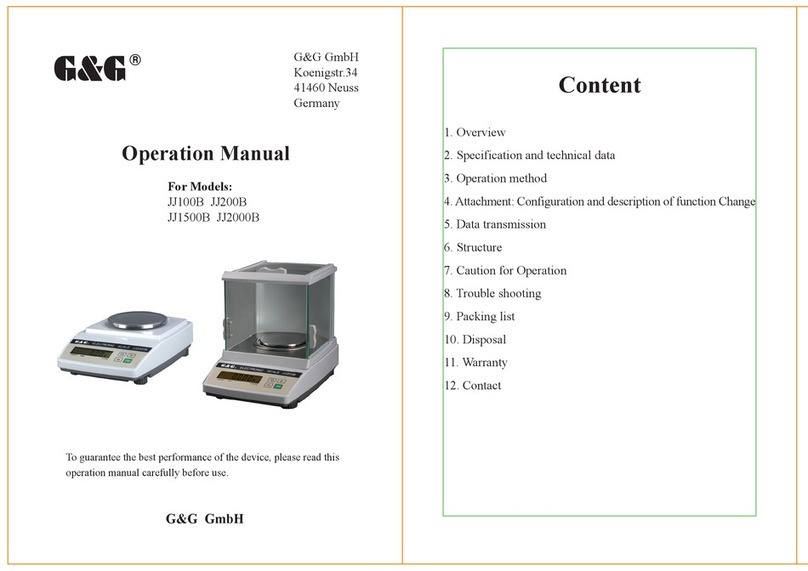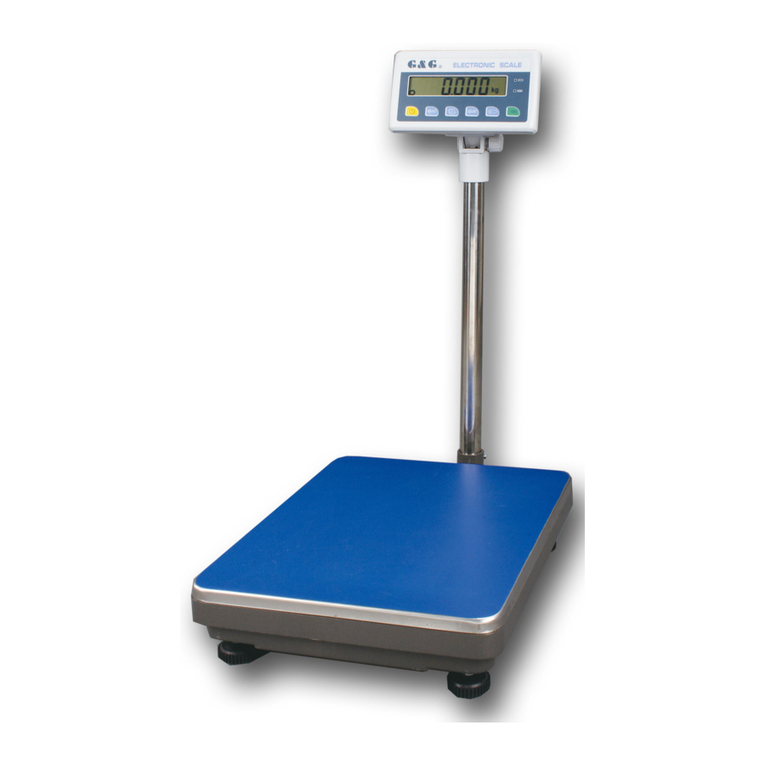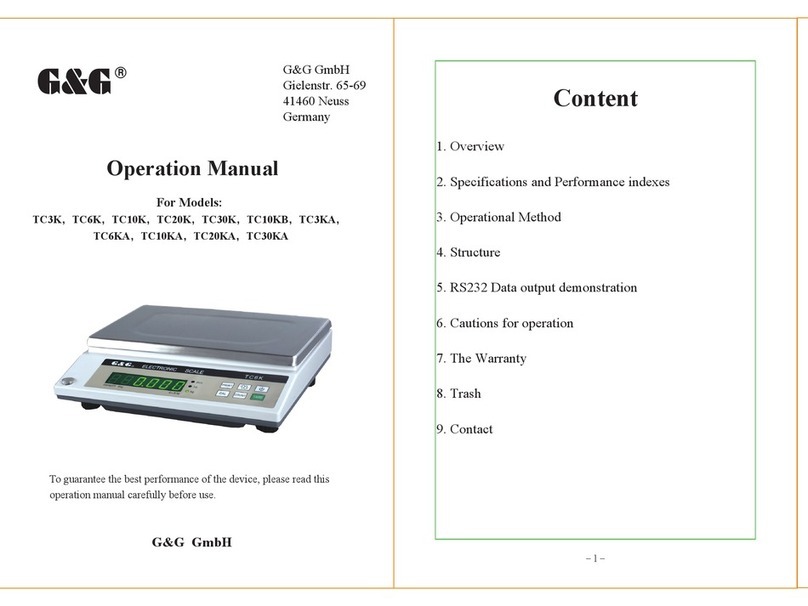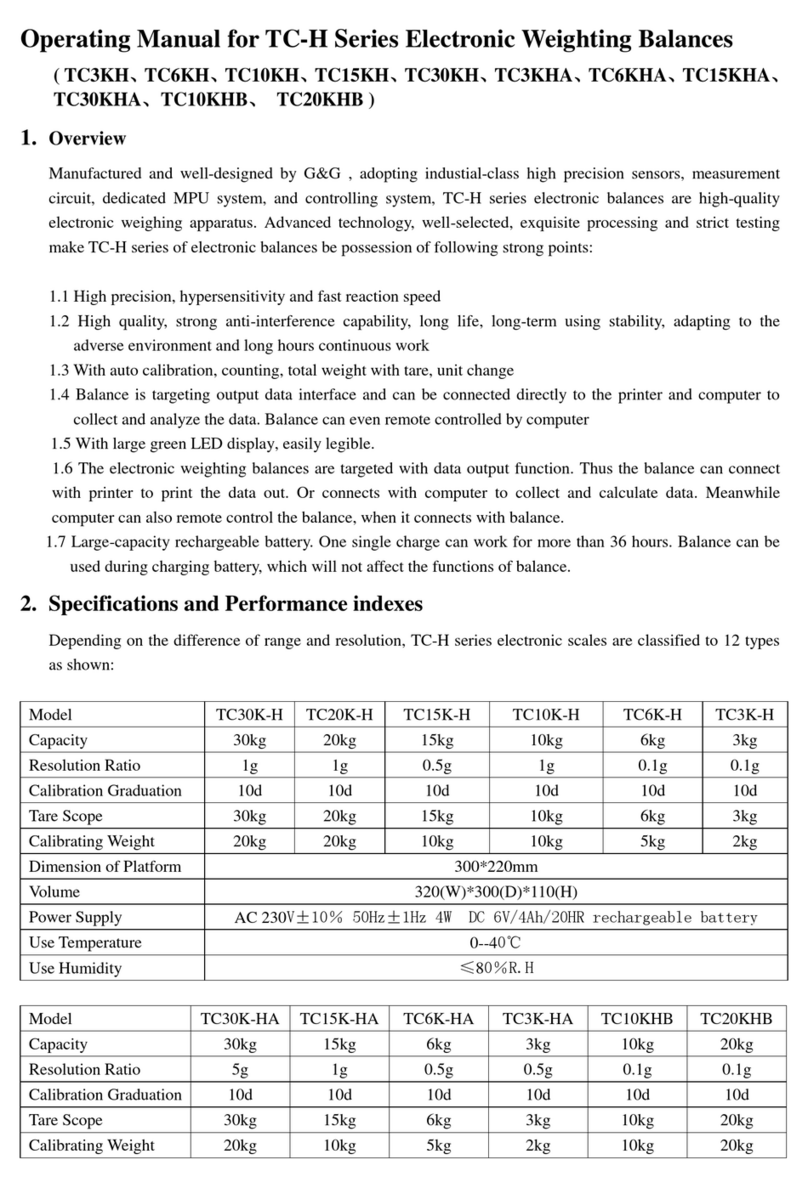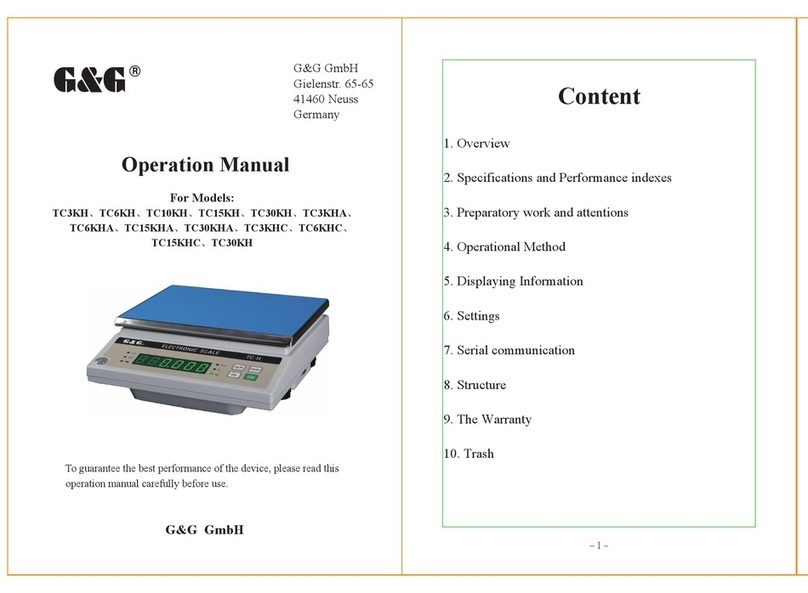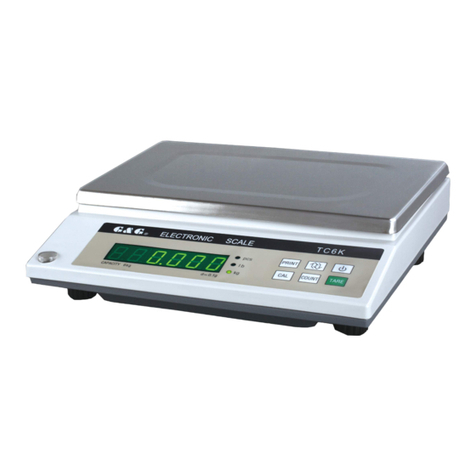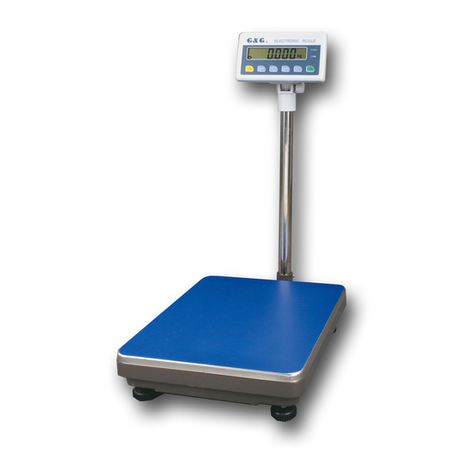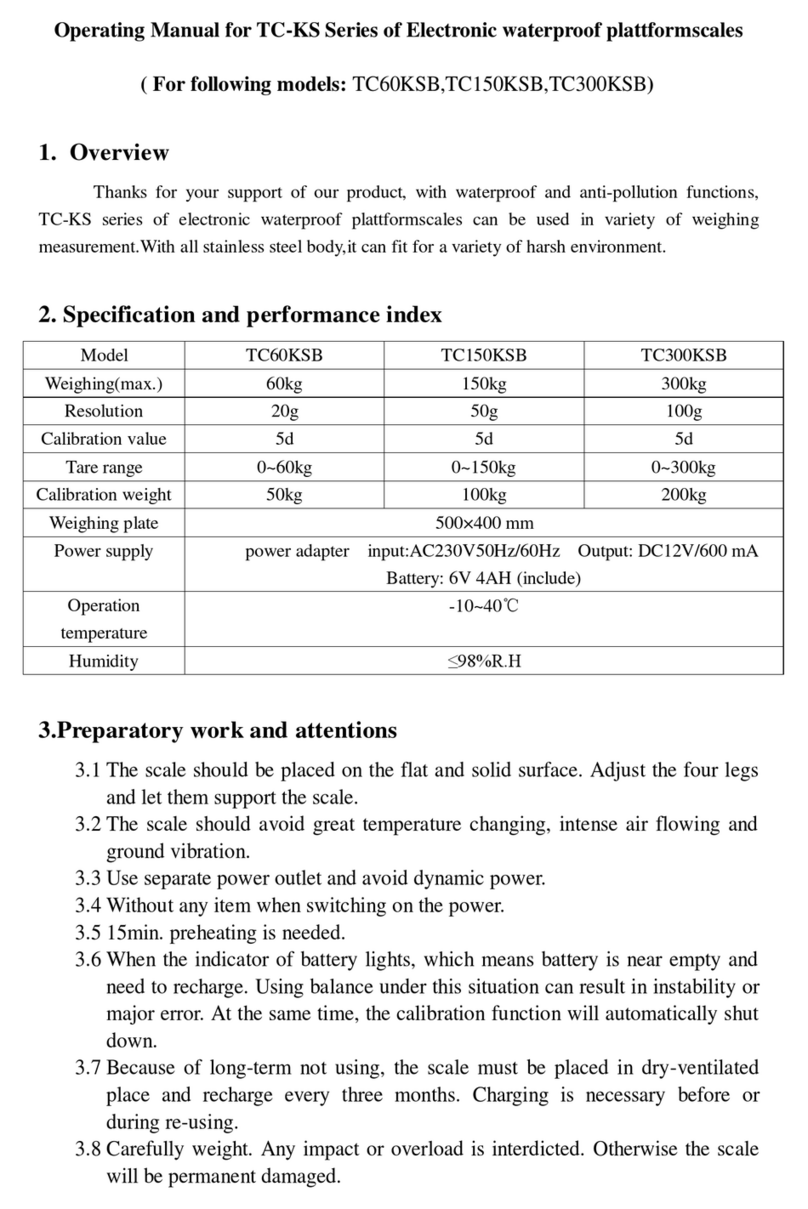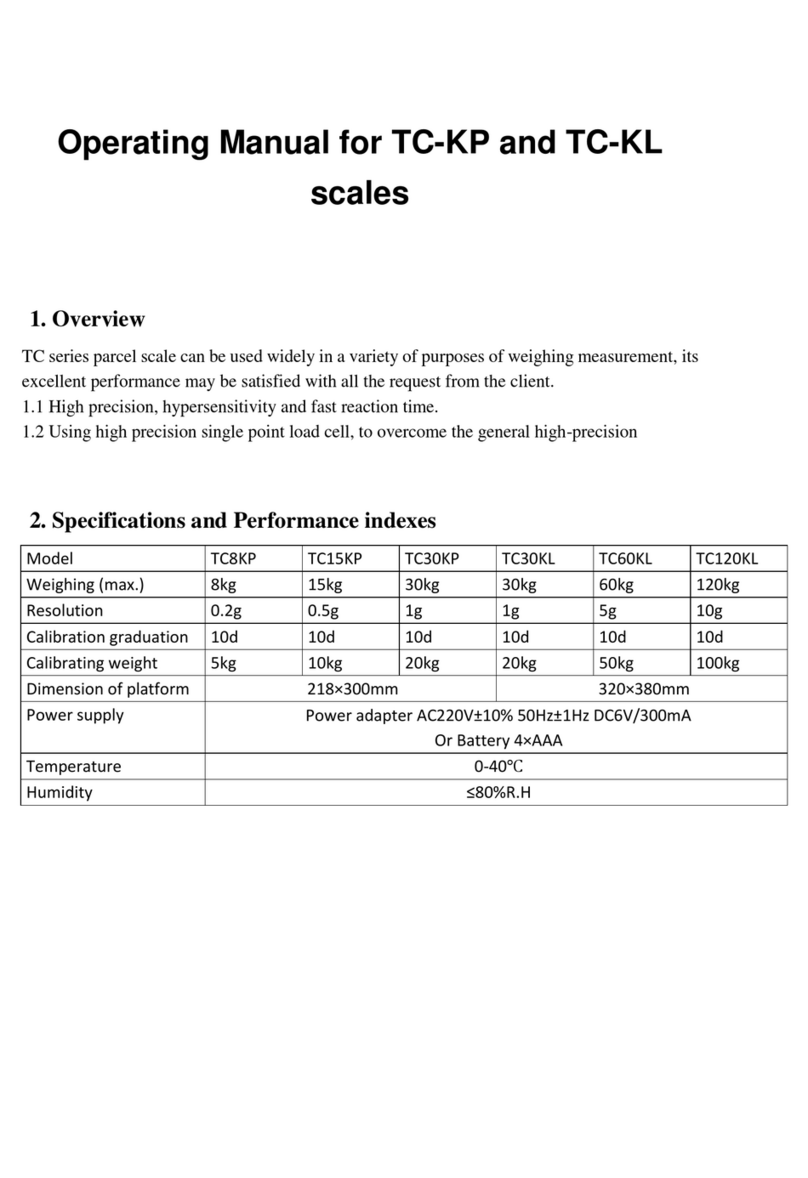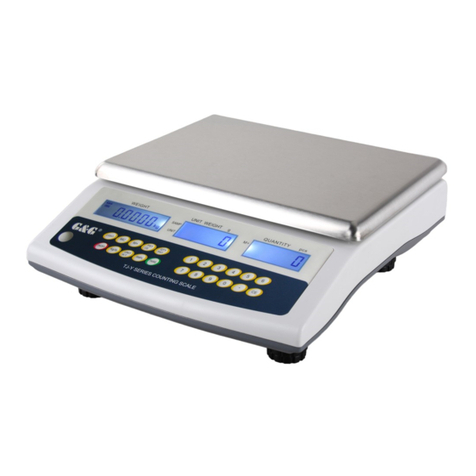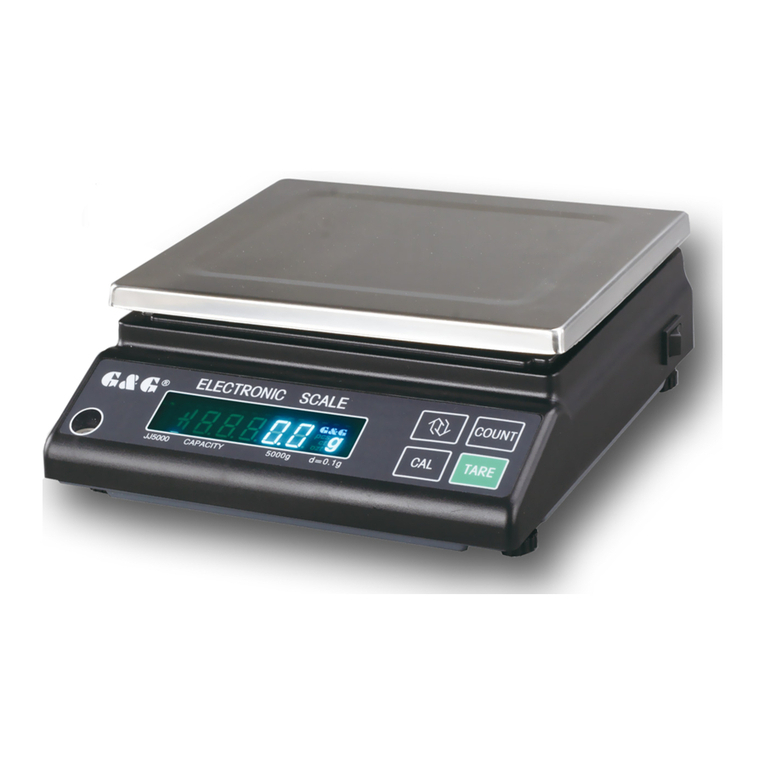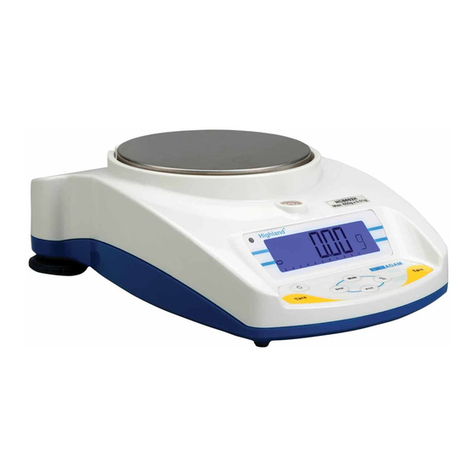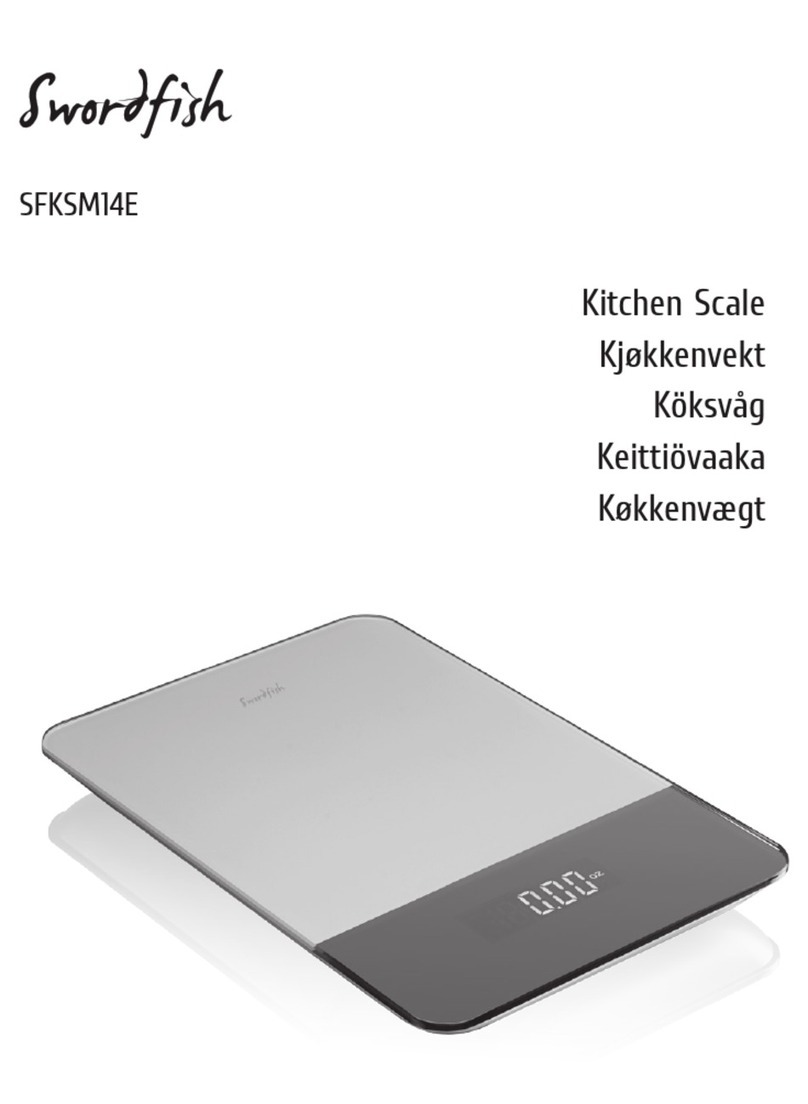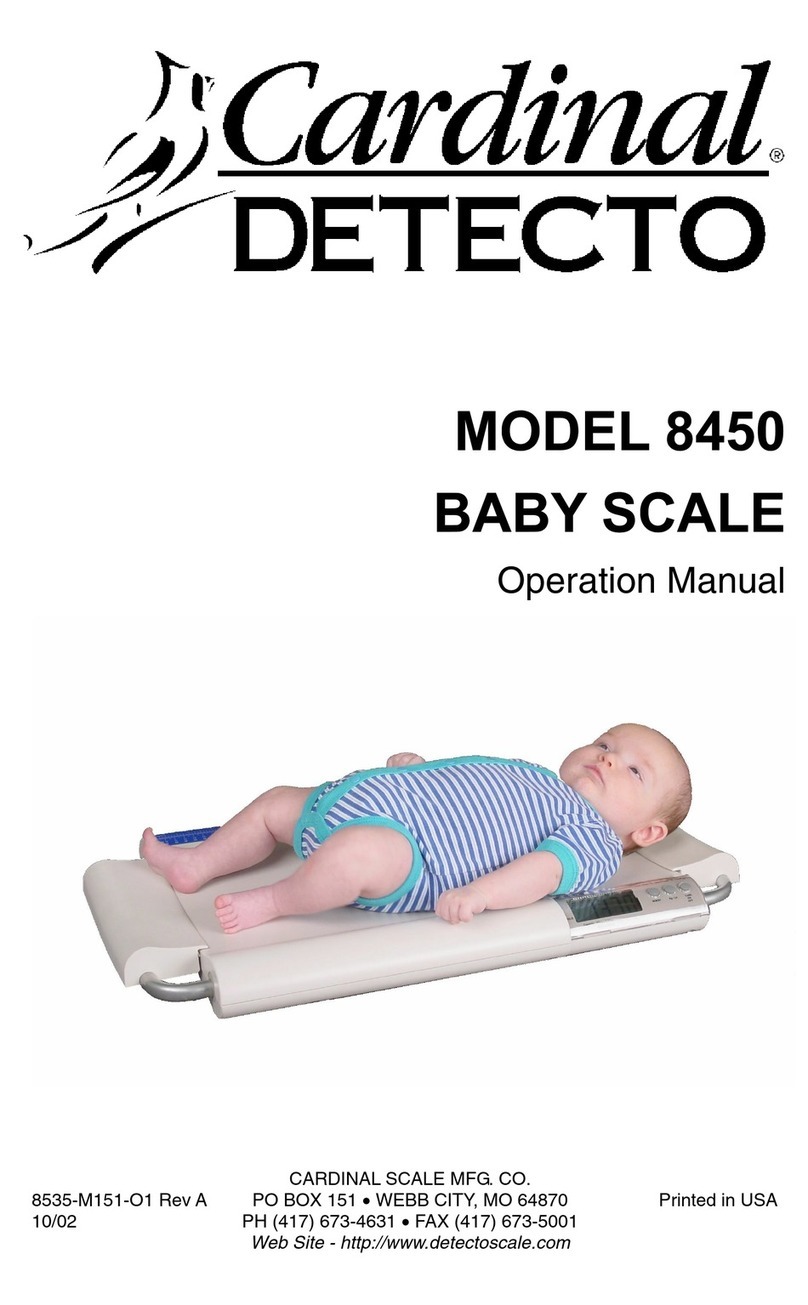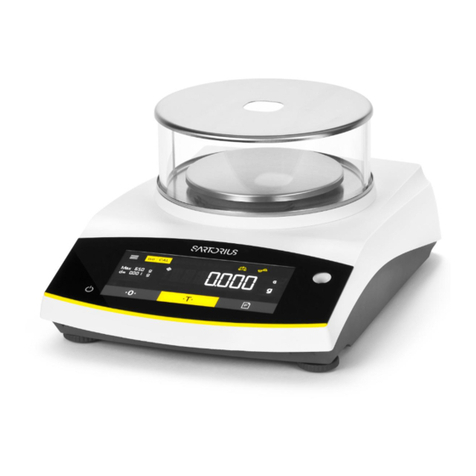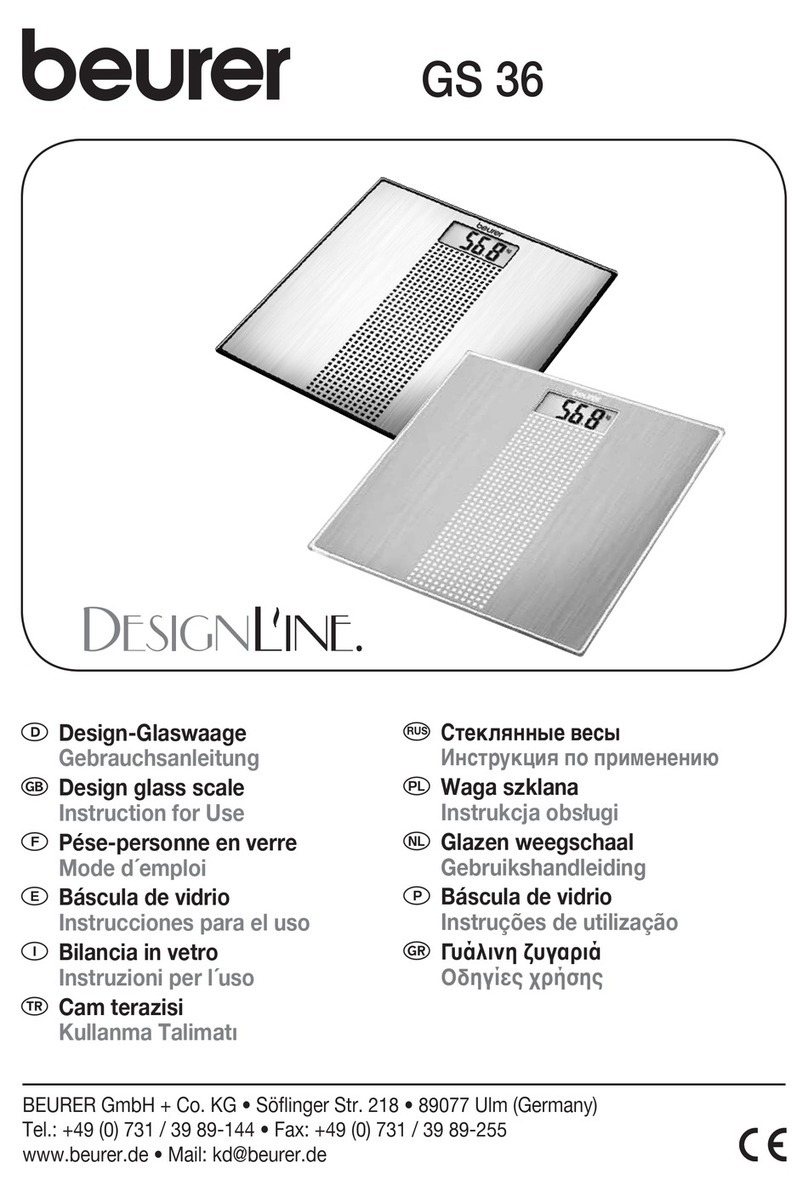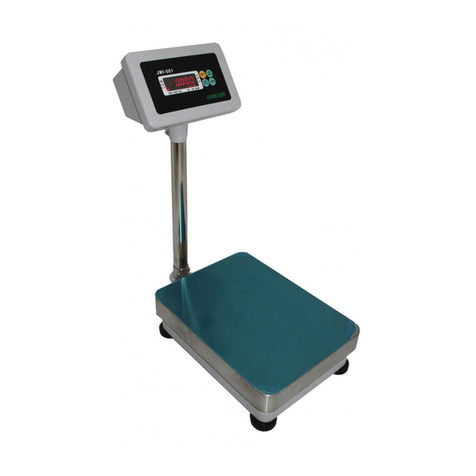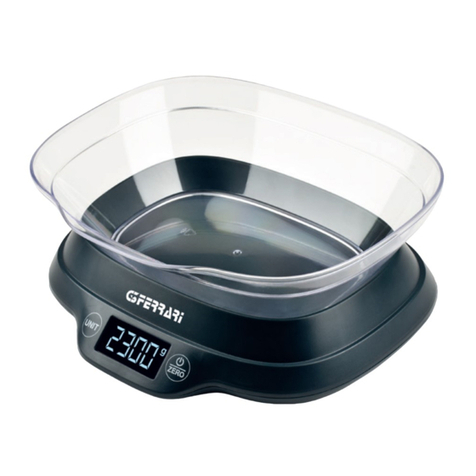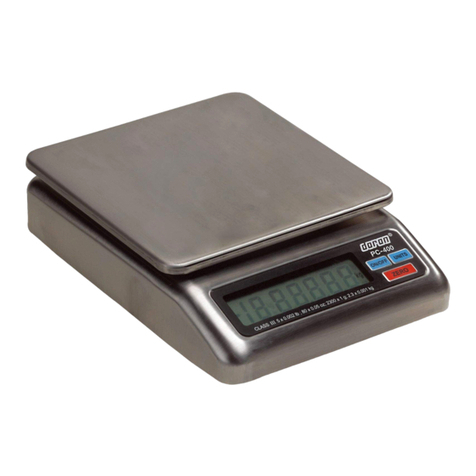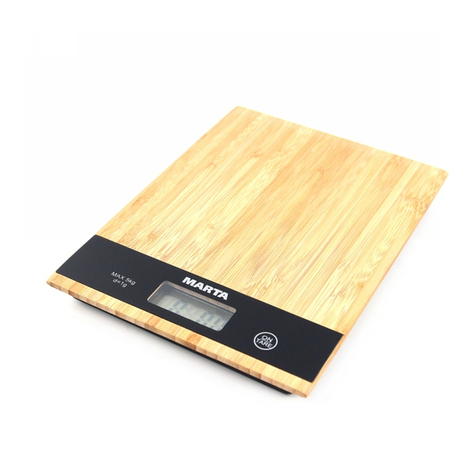G&G JJ-BC Series User manual

Operating Instruction
N o v e s i a s t r . 3 1
4 1 5 6 4 K a a r s t
G e r m a n y
T e l . : + 4 9 / ( 0 ) 2 1 3 1 / 1 3 3 5 6 0 5
F a x . : + 4 9 / ( 0 ) 2 1 3 1 / 1 3 3 5 6 0 7
Version 1.1 09/2019 EN
Laboratory / Analytical balances JJ-BC
To ensure the correct application of the scales of this series,
please read these instructions carefully and properly
preserved for future reference.

G&G GmbH | Technical data
2
Manual Version 1.1
09/2019
EN
Contents
1Technical data.......................................................................................Fehler! Textmarke nicht definiert.
1.1 JJ223BF-JJ1523BF (3 Digits) ...........................................................Fehler! Textmarke nicht definiert.
1.2 JJ124BF-JJ324BF (4 Digits) .............................................................Fehler! Textmarke nicht definiert.
2Overview.....................................................................................................................................................4
2.1 Proper Use...........................................................................................................................................6
2.2 Improper Use.......................................................................................................................................6
2.3 Control of inspection, measuring and test equipment.......................................................................7
3Warranty.....................................................................................................................................................7
4Basic Safety Precautions.............................................................................................................................7
5Transportation and Storage........................................................................................................................8
5.1 Acceptance check................................................................................................................................8
5.2 Packing ................................................................................................................................................8
6Unpacking, Setup and Commissioning .......................................................................................................8
6.1 Installation Site, Location of Use.........................................................................................................8
6.2 Unpacking / Installation ......................................................................................................................9
6.3 Mains connection................................................................................................................................9
6.4 Connection of peripheral devices .......................................................................................................9
6.5 Initial Commissioning ..........................................................................................................................9
7Adjustment .................................................................................................................................................9
7.1 Calibration .........................................................................................................................................10
8Operating elements..................................................................................................................................10
9Basic Operation.........................................................................................................................................11
9.1 [Power On/OFF] ................................................................................................................................11
9.2 TARE ..................................................................................................................................................11
9.3 CAL - [calibration with external weight] ...........................................................................................11
9.4 UNIT - [multifunctional key].............................................................................................................11
9.4.1 Weighing unit selection [weighing mode].................................................................................11
9.5 Print function [print mode] ...............................................................................................................11
9.6 Pieces counting function [counting mode] .......................................................................................12
9.7 Underfloor weighing .........................................................................................................................12
10 Density determination (Hydrostatic weighing) ....................................................................................12

G&G GmbH | Technical data
3
10.1 Density determination of solids ........................................................................................................13
10.2 Determining density of liquids ..........................................................................................................13
10.3 Influencing magnitudes and error sources .......................................................................................13
11 Displayinformation / Error messages ...................................................................................................14
12 Interface RS 232C..................................................................................................................................14
12.1 Technical Data ...................................................................................................................................14
12.2 Description of the data transfer........................................................................................................14
12.3 Remote control instructions .............................................................................................................15
12.4 RS232 Pinout (9-pin D-Sub)...............................................................................................................15
13 Configuration & Explain of the function setting ...................................................................................16
14 Maintenance and Servicing...................................................................................................................17
14.1 Cleaning.............................................................................................................................................17
14.2 Maintenance and repair....................................................................................................................17
14.3 Disposal .............................................................................................................................................17
15 Instant help ...........................................................................................................................................18

G&G GmbH | Technical data
4
1Technical data
1.1 JJ223BF-JJ1523BF (3 Digits)
Modell
JJ223BC
JJ323BC
JJ523BC
JJ623BC
JJ1023BC
JJ1523BC
Weighing range (max)
220g
320g
520g
620g
1020g
1520g
Readability ( =d)
1mg
1mg
1mg
1mg
1mg
1mg
Tare range
0-220g
0-320g
0-520g
0-620g
0-1020g
0-1520g
Linearity
± 3mg
± 3mg
± 3mg
± 3mg
± 3mg
± 3mg
Reproducibility
± 2mg
± 2mg
± 2mg
± 2mg
± 2mg
± 2mg
Stabilization time
< 3 s
< 4 s
Operating
temperature
15-30 °C
18-23 °C
Humidity
(40-80)%RH
(50-70)%RH
Weighing plate
Ø 80 mm
Ø 120 mm
Calibration weight *
200g
200g
500g
500g
1000g
1000g
Minimum weight **
20 mg
Warming up time
1 h.
Minimum piece
weight ***
1mg
Reference piece
numbers for piece
count
1, 10, 20, 50, 100
Weighing units
g (gram), ct (carat), ozt (troy ounce), oz (ounce),
GN (gran), dwt (pennyweight), lb (pound)
Dimensions
(W x D x H)
220 (B) × 360 (T) × 345 (H) mm
Net weight
10 kg
Underfloor weighing
Yes
Interface
RS 232C
Power supply
AC 230V±10% 50Hz/60Hz
Auto power off
No
* Needed reference weight for a new calibration
**Minimum weight that must be placed on the scale. If you place 1mg on a scale with
20mg minimum weight, it will not be shown and stay on “0”
*** Minimum weight of a single piece during counting

G&G GmbH | Technical data
5
1.2 JJ124BC-JJ324BC (4 Digits) + JJ2202BC-JJ3202BC (2 Digits)
Modell
JJ124BC
JJ224BC
JJ323BC
JJ2202BC
JJ3202BC
Weighing range (max)
120g
220g
320g
2200g
3200g
Readability
0,1mg
10mg
Minimum weight **
2 mg
200 mg
200 mg
Tare range
0-120g
0-220g
0-320g
0-2200g
0-3200g
Linearity
± 0,3mg
± 30mg
Reproducibility
± 0,2mg
± 20mg
Stabilization time
< 4 s
< 3 s
Operating
temperature
18-23 °C
15-30 °C
Humidity
(50-70)%RH
(40-80)%R.H
Weighing plate
Ø 80 mm
190*205mm
Calibration:
External
Calibration weight *
100g
200g
200g
2000g
2000g
Warming up time
60 min
Minimum piece
weight***
0,1 mg
10mg
Reference piece
numbers for count
1, 10, 20, 50, 100
Weighing units
g (gram), ct (carat), ozt (troy ounce), oz (ounce),
GN (gran), dwt (pennyweight), lb (pound)
Dimensions
(W x D x H)
220 (B) × 360 (T) × 345 (H)
mm
220(B)×360(T)×120(H)m
m
Net weight
10 kg
8 kg
Underfloor weighing
Yes
Interface
RS 232C
Power supply***
AC 230V±10% 50Hz/60Hz
Auto power off
No
* Needed reference weight for a new calibration
**Minimum weight that must be placed on the scale. If you place 1mg on a scale with
2mg minimum weight, it will not be shown and stay on “0”
*** Minimum weight of a single piece during counting

G&G GmbH | Overview
6
2Overview
The laboratory analytical balance JJ-BC is designed to meet the needs of laboratories, industry and
commercial users and it offers very wide range of functions: weighing, parts counting or density
determination.
It is equipped with a very precise sensor, using the electromagnetic force compensation sensor. This
measurement technology is much more precise than the classic stain gauge load cell.
The Series JJ-BC is available in various models with a measuring range between 0,0001g and 0,01g, with
capacities of up to 3,2kg.
Models with 0,001g readout or finer come with a big wind shield.
Electromagnetic force compensation technology.
High precision, sensitivity and rapid response time.
High quality materials and an optimized power supply.
High reliability and long service life.
A robust base made of powder coated aluminum cast.
An easy-cleaning, durable and stable metal shell with glass wind protection.
A removable stainless steel pan can be cleaned easily.
A Level Indicator, four adjustable feet.
External calibration, zeroing searches, parts counting function, tare function, density determination
7 Weighing units (g, ct, ozt, oz, GN, dwt, lb).
Large LCD display with backlight, digit height 15 mm.
An integrated RS-232-interface enables you to automatically send the weighing data to PC
Powered by the external mains adapter.
2.1 Proper Use
The balance you purchased is intended to determine the weighing value of material to be weighed. It is
intended to be used as a “non-automatic” balance, i.e. the material to be weighed is manually and
carefully placed in the center of the weighing plate. As soon as a stable weighing value is reached the
weighing value can be read.
2.2 Improper Use
Do not use the balance for dynamic weighing. In the event that small quantities are removed or added
to the material to be weighed, incorrect weighing results can be displayed due to the “stability
compensation” in the balance. (Example: Slowly draining fluids from a container on the balance.)
Do not leave permanent load on the weighing plate. This may damage the measuring system.
Impacts and overloading exceeding the stated maximum load (max) of the balance, minus a possibly
existing tare load, must be strictly avoided. Balance may be damage by this.
Never operate the balance in explosive environment. The balance is not explosion protected.
The structure of the balance may not be modified. This may lead to incorrect weighing results, safety-
related faults and destruction of the balance.
The balance may only be used according to the described conditions. Other areas of use must be
released by G&G in document.

G&G GmbH | Warranty
7
2.3 Control of inspection, measuring and test equipment
As part of quality assurance the measuring-related properties of the balance and the available adjusting
weight must be checked regularly. The responsible user must define a suitable interval as well as the
nature and scope of this test. Information regarding the test equipment of scales and of the required test
weights is available on the G & G Company - Homepage. (www.gandg.de)
3Warranty
The G & G Company is liable for the defects within the framework of existing legislation.
We warrant the product manufactured by us to be free from defective material or factory
workmanship and agree to repair or replace this product which, under normal use and service, disclose
the defect to Bethe fault of our manufacturing, with no charge for parts and service. If we are unable to
repair or replace this product, we will make a full refund of the purchase price.
Consult the user's manual for proper instruction regarding use of this instrument. Our obligation under
this warranty is limited to repairing, replacing or making refund of this test equipment which proves to
be defective within 24 months from the date of original purchase.
Warranty claims shall be voided in case:
Our conditions in the operation manual are ignored
The appliance is used outside the described uses
The appliance is modified or opened
Mechanical damage or damage by media, liquids, natural wear and tear
The appliance is improperly set up or incorrectly electrically connected
The measuring system is overloaded
4Basic Safety Precautions
Environmental conditions: only use indoor, check the detailed environment conditions for
temperature and humidity in the technical details above.
Do not use the scale in any high temperature fluctuations and avoid strong airflows, vibrations and
dust. The balance could never get wet and make sure that the balance is not used in an environment
with extreme temperature and humidity.
Do not use the balance in explosive conditions.
Only use the extender cable, which with ground wire.
If the power line cable is damaged, the appliance must be unplugged immediately and the power line
cable be replaced.
Place the balance on a stable surface and set it horizontally with the help of the adjustable feet and the
spirit level.
The electronic balance is a precision measuring instrument and must be handled with great care.
Violation of limit of weighing range or impact can cause permanent damage to the balance.
The balance needs a warm up time for about 1 hour before using.
Please do not use aggressive cleaning agents (solvents or similar agents), but a cloth dampened with
mild soap suds. Ensure that no liquid penetrates into the device and wipe with a dry soft cloth.
Do not overload the balance more than 20% of maximum load (Max). Do not press the pan with a
hand!

G&G GmbH | Transportation and Storage
8
By maintenance please notice the information in Chapter “Maintenance and Servicing”.
If the balance seems not to operate properly, unplug it from the mains and do not use until checked by
authorized service.
All repairs and necessary regulations can be made by authorized personnel only.
COUTION!:Carefully read this operation manual before setup and commissioning.
5Transportation and Storage
5.1 Acceptance check
When receiving the appliance, please check packaging immediately, and the appliance itself when
unpacking for possible visible damage.
5.2 Packing
Keep all parts of the original packaging for a possibly required return
Only use original packaging for returning.
Prior to dispatch disconnect all cables and remove loose/mobile parts.
Reattach possibly supplied transport securing devices.
Secure all parts such as the glass wind screen, the weighing platform, power unit etc.
against shifting and damage.
6Unpacking, Setup and Commissioning
6.1 Installation Site, Location of Use
The balances are designed in a way that reliable weighing results are achieved in common conditions of
use. You will work accurately and fast, if you select the right location for your balance.
Therefore, observe the following for the installation site:
Major weighing deviations (incorrect weighing results) may be experienced should electro-
magnetic fields (e.g. due to mobile phones or radio equipment), static electricity accumulations
or instable power supply occur. Change location or remove source of interference.
Place the balance on a firm, level surface;
Avoid extreme heat as well as temperature fluctuation caused by installing next to a radiator or in the
direct sunlight;
Protect the balance against direct draughts due to open windows and doors;
Avoid jarring during weighing;
Protect the balance against high humidity, vapors and dust;
Do not expose the device to extreme dampness for longer periods of time.
Non-permitted condensation (condensation of air humidity on the appliance) may occur if a cold
appliance is taken to a considerably warmer environment. In this case, acclimatize the disconnected
appliance for ca. 4 hours at room temperature.
Avoid static charge of goods to be weighed or weighing container.

G&G GmbH | Adjustment
9
6.2 Unpacking / Installation
Carefully remove the balance from the packaging, remove plastic cover and setup balance at the intended
workstation.
1. Take the balance and supplied accessories (a feeder, pan elements) out of the box.
2. Place the balance on a stable ground not affected by mechanical vibrations and airflows.
3. Level the balance with foot screws so that the air bubble in water-level is in the middle.
4. Plug the adapter to the power socket at the back of the balance.
5. Connect the power adapter to an AC220V ± 10% 50Hz ± 1Hz outlet.
Scope of delivery:
Balance
Glass wind protection
Weighing pan
Power line cable
Operating instructions
6.3 Mains connection
Before connecting the mains adapter check if the printed voltage value is the same as the local supply
voltage.
6.4 Connection of peripheral devices
The balance may send data to a computer or a printer through RS232C port.
When cooperating with the balance, a computer should be equipped with a program which enables
processing data from the balance.
Before connecting or disconnecting of additional devices (printer, PC) to the data interface, always
disconnect the balance from the power supply.
6.5 Initial Commissioning
In order to obtain exact results with the electronic balances, your balance must have reached the
operating temperature (warming up time 1 hour). During this warming up time the balance must be
connected to the power supply (mains, accumulator or battery).
The accuracy of the balance depends on the local acceleration of gravity.
Please read the information carefully in chap. “Adjustment”.
7Adjustment
As the acceleration value due to gravity is not the same at every location on earth, each balance must be
coordinated - in compliance with the underlying physical weighing principle - to the existing acceleration
due to gravity at its place of location (only if the balance has not already been adjusted to the location in
the factory). This adjustment process must be carried out for the first commissioning, after each change of
location as well as in case of fluctuating environment temperature. To receive accurate measuring values it
is also recommended to adjust the balance periodically in weighing operation.

G&G GmbH | Operating elements
10
For an external calibration, you need a reference weight that has a smaller tolerance than the scales
readout. During the calibration the scale will “learn” how “heavy” a specific weight is at the local
environment conditions and adjust according to this. Due to this, it is important that the reference weight
has a smaller tolerance than the scale can determine the weight. We recommend to use weights that are
produced within the OIML-Tolerance classes (E2 for example). Which weight is required for which scale,
can be found in the table of technical data.
7.1 Calibration
The scale must be turned on for at least the required warm up time, display is on “0”.
Press and hold the “CAL”key until the display changes to "C XXX".
XXX is the required weight of the reference weigh, when it displays "C 100" now a 100g weight must be
placed in the middle of the plateframe. After a view seconds, the calibration weight displayed and the
stable weight symbol "g" shows that means the calibration is complete.
If after pressing “CAL" key the scale shows "C----F", the zero point is unstable. Use the "TARE" key return to
zero. Now press the "CAL" key again.
8Operating elements
1. Weighing pan 2. Pan support ring 3. Wind protection 4. Underfloor weighing widget
5. Sealing cap 6. Adjustable feet 7. RS232 Interface 8. Level Indicator
9. Power socket 10. AC adapter cable 11. ON/OFF key 12. Calibration key
13.Unit change key 14. Counting key 15.Print key 16.Tare key

G&G GmbH | Basic Operation
11
9Basic Operation
After new purchase of the balance or after a long storage, you have to calibrate the balance before the first
commissioning. Level the balance with the adjustable feet horizontal until the air bubble in the level is in
the center of the Level Indicator. Give the balance after changing the location a warm-up time min. 1 hour
before using. This time is necessary for the balance to adapt to the eventual temperature.
9.1 [Power On/OFF]
Press the [On/OFF] button to turn on the balance. The display shows the message "ON". Then the max.
weighing range is displayed. The balance will carry out a self-test (F----1to F----9). When the "0.0000 g" in
display appears, the balance is ready for operation.
Press the [On/OFF] button and keep it pressed, until the display shows the message “OFF”. The balance
will switch off then.
9.2 TARE
When the pan is empty and indication is different than zero press [TARE] key.
Weighing with tare: Place the weighing box and press the [TARE] button. After standstill control the zero
display appears. The weight of the container is now internally saved. Weigh the material, the net weight
will be indicated. The weight of the weighing container will be displayed as a minus number after removing
the weighing container. The tare weight is saved until it is deleted. Remove the load from the balance and
press the [TARE] button. The tare procedure can be repeated as many times as necessary, for example
with initial weighing of several components for a mix (add-on weighing). The limit is reached when the
total weighing range capacity is full.
9.3 CAL - [calibration with external weight]
The balance has an external calibration function.
The adjustment procedures see chap. "External calibration”.
9.4 UNIT - [multifunctional key]
The [UNIT] - button is a multi-function button.
9.4.1 Weighing unit selection [weighing mode]
Under the weighing mode, use the UNIT key to choose weighing units: g (gram), ct (carat), ozt (troy ounce),
oz (ounce), GN (gran), dwt (pennyweight) and lb (pound).
1 g = 5 ct
= 0.032150747 ozt
= 0.035273962 oz
= 15.43235835 GN
= 0.643014931 dwt
= 0.0022046226 lb
9.5 Print function [print mode]
The balance can be connected via the RS232C interface directly to a printer or PC.
Press the “PRINT” key to send the weight to the output device.

G&G GmbH | Density determination (Hydrostatic weighing)
12
9.6 Pieces counting function [counting mode]
Before the balance can count parts, it must know the average part weight (i.e. reference). Proceed by
putting on a certain number of the parts to be counted. The balance determines the total weight and
divides it by the number of parts, the so-called reference quantity (1, 10, 20, 50, or 100). Counting is then
carried out on the basis of the calculated average piece weight.
As a rule: The higher the reference quantity the higher the counting exactness.
Follow these steps:
a) Place as many pieces to add-up as required by the reference quantity. Press the “COUNT”key, display
“1”that means into the counting mode, Press the [UNIT] button to enter the setting menu. The display
now shows the number "1" and the unit "Pcs". Using the [UNIT] button select the reference quantity
(1, 10, 20, 50, or 100).
b) After successful reference determination the current quantity is displayed and the unit “Pcs”.
c) Remove reference weight. The balance is now in parts counting mode counting all units on the
weighing plate.
9.7 Underfloor weighing
Objects unsuitable for placing on the weighing scale due to size or shape may be weighed with the help of
the underfloor weighing device.
Proceed as follows:
Switch off the balance
Open the Sealing cap at the balance bottom.
Suspend hook for underfloor weighing carefully and completely.
Place weighing balance over an opening.
Attach load to hook and carry out weighing procedure.
Always ensure that all suspended objects are stable enough to hold the desired
goods to be weighed safely (danger of breaking).
Never suspend loads that exceed the stated maximum load (max) (danger of
breaking).
Always ensure that there are no persons, animals or objects that might be
damaged underneath the load.
After completing the underfloor weighing the opening on the bottom of the
balance must always be closed (dust protection).
10 Density determination (Hydrostatic weighing)
According to the Archimedes’ principle, any object, wholly or partially immersed in a fluid, is buoyed up by
a force equal to the weight of the fluid displaced by the object. In other words, an immersed object is
buoyed up by a force equal to the weight of the fluid it actually displaces.
For the density determination of solid material, the solid is weighed first in air and then in the measuring
liquid. Because of the density of the water is 1.0 g/cm ³, can determine the volume of the displaced water
and also the volume of object. From the weight difference results the buoyancy calculates the density.
The density is determined with help of the underfloor weighing device.
Hydrostatic density determinations succeed only with the objects, which have a
higher density than water (1 g/cm3).

G&G GmbH | Density determination (Hydrostatic weighing)
13
Example:
A piece of metal in the air weight 100 g and weighs 80 g in water. Therefore, the object has 20 g (= 20 cm³)
water displaced. Its volume is therefore 20 cm³. Now it is easy to determine the density of the metal piece.
10.1 Density determination of solids
For the density determination of solid material, the solid is weighed first in air [ A ] and then in the
measuring liquid [ B ]. If the density of the buoyancy medium [ ρo ] is known, the density of the solid [ ρ ] is
calculated as follows:
= Density of the sample
= Weight of the sample in air
= Weight of the sample in the measuring liquid
= Density of the measuring liquid
10.2 Determining density of liquids
For density determination of liquids, a glass sinker is used, whose volume ([ V ] see embossing) is known.
The glass sinker is weighed first in air [ A ] and then in the liquid [ B ] whose density is to be determined.
According to the Archimedes’ principle, any object, wholly or partially immersed in a fluid, is buoyed up by
a force equal to the weight of the fluid displaced by the object.
The volume [ V ] of the glass sinker is same as the volume of the displaced liquid.
Buoyant force of the glass sinker = weight of the glass sinker in air [ A ] - weight of the glass sinker in the
measuring liquid [ B ]
That implies that:
= Density of the sample liquid
= Weight of the glass sinker in air
= Weight of the glass sinker in the measuring liquid
= Volume of the glass sinker
= Density of air (0.0012 g/cm3)
10.3 Influencing magnitudes and error sources
Air Pressure
Temperature
Volume deviation of the sinking object (± 0.005 cm3)
Surface tension of the liquid
Air bubbles
Immersion depth of the sinking object
Porosity of the object

G&G GmbH | Displayinformation / Error messages
14
11 Displayinformation / Error messages
F----1Date over display scope
F----2A/D-switch disorder
F----3Function key disorder
F----5Sensor signal disorder / Load Cell defect
F----LLower zero position of sensor signal
F----HWeighing capacity is exceeded
C----FCalibration error, instability or not at zero point during calibrating
C----HCalibration error, items on the pan or at higher zero point during calibrating
E----- Storage calibration data error, re-calibration is necessary
------ Zero point of the scale disorder / mechanical defect of the scale
Should other error messages occur, switch balance off and then on again. If the error
message remains inform manufacturer.
12 Interface RS 232C
An integrated RS-232-interface enables you to automatically send the weighing data to PC. Relevant codes
and control commands are specified as following.
12.1 Technical Data
8-bit ASCII Code
1 start bit, 8 data bits, 1 stop bits, no parity bit
Bit rates supported include: 600, 1200, 2400, 4800 and 9600 bit/s. (default setting is 600)
Miniature plug is necessary (9 pin D-Sub)
For operation with interface faultless operation is only ensured with the correct G&G –interface
cable (max. 2m)
12.2 Description of the data transfer
Symbols
-/+
minus-sign / for positive numbers this is output as blank
Data
value of weight / decimal, depending on weighing value
Unit
Units / Pcs.
STP
stop character
CR
Carriage Return
Data format: 14-bits Output (ASCII Code):
-/+
Data
Unit
STP
CR
2 bits
7 bits
3 bits
1 bit
1 bit

G&G GmbH | Interface RS 232C
15
12.3 Remote control instructions
Via the RS232 data interface, the computer can control the balance with subsequent commands.
If the transmit / device setting is 27 (27=1Bhex, default setting), the remote control commands are sent to
the balance by ASCII code:
1BH+70H (ACSII Code p): sending data (Print)
1BH+71H (ACSII Code q): calibration function is active (CAL - Key)
1BH+72H (ACSII Code r): Counting function is active
1BH+73H (ACSII Code s): Weighing unit selection
1BH+74H (ACSII Code t): Taring (TARE - Key)
12.4 RS232 Pinout (9-pin D-Sub)
DE-9 plug pin-out (9-pin., male), as it is usually
available at DTE
DE-9 socket pin-out (9-pin., female), as it is
usually available at DCE
DTE - data terminal equipment (Terminals resp. computer)
DCE - data circuit-terminating equipment (Balance)
Signal
Pin
Origin
Abbreviation
Name
Typical purpose
DE-9
DTE (e.g. PC)
DCE (e.g. Balance)
RxD
Receive Data
Carries data from DCE to DTE.
2
Input
Output
TxD
Transmit Data
Carries data from DTE to DCE.
3
Output
Input
GND
Ground
5
-
-
Application Example:
If the setting is C3---2, C4---27 (default setting), the codes shown in VB as following:
MSComm1.Settings = "600,n,8,1"
MSComm1.Output = Chr(&H1B) + Chr(&H70) ’sent a print commando
’or MSComm1.Output = Chr(27) + Chr(112)
’or MSComm1.Output =Chr(27) +"p"
Do
DoEvents
Loop Until MSComm1.InBufferCount = 14
a = MSComm1.Input
Print a
Software and additional manuals can be downloaded at https://gandg.de

G&G GmbH | Configuration & Explain of the function setting
16
13 Configuration & Explain of the function setting
The settings of the balance can be changed in the setting menu. This way, the balance can be adjusted to
individual weighing requirements. By the factory the user menu has been set in a way that normally no
more changes must be made, only at special conditions of use.
Overview:
In the off state press the [CAL] button and keep it pressed, press the [ ] button turn on the balance. Now
the balance is accessed to the setting menu. Using the [CAL] button the individual menu items (C1-C4) can
be selected one after the other. Press the [TARE] button to change the setting value. After all points have
been configured, press [CAL] button returns the balance automatically into weighing mode.
a) C1 = sensitivity setting - values: 0 1 2 3 4
The higher the value, the lower the sensitivity and higher stability.
Filter 0: Setting for dispensing. Scale reacts very fast but also is very vulnerable to bad environment
conditions.
Filter 1/2: Sensitive and fast, very quiet using location.
Filter 3/4: Robust but slow, busy using location.
b) C2 = filtering strength setting - values: 0 1 2 3
The higher the value, the lower the sensitivity and higher stability.
Filter 0: Setting for dispensing. Filter is deactivated, scale reacts very sensitive but also is very
vulnerable to bad environment conditions.
Filter 1/2: Sensitive and fast, very quiet using location.
Filter 3: Robust but slow, busy using location.
c) C3 = serial port setting - transmission speed (RS-232)
2(600), 3(1200), 4(2400), 5(4800), 6(9600) - Default setting is 2.
d) C4 = device number / communication setting (RS-232)
Press [TARE] button changes the value smaller. Press [ ] button changes the value bigger. The
number corresponds to the first data signal to the command control of the computer.
Default setting is 27 (1Bhex).
e) C5 = setting the mode for the backlight
0(always on), 1(automatic after the weight has changed), 2(usually off) - Default setting is 0.
f) C6 = setting the internal calibration function
0(Internal calibration function on),
1(Internal calibration function off,press the “CAL”key the internal calibration will not work),
2(change the “CAL”key as the external calibration key,press “CAL”key the balance begin the external
calibration mode) –
Default setting is 0.

G&G GmbH | Maintenance and Servicing
17
g) Save settings
After all points have been configured, press [CAL] button returns the balance automatically into
weighing mode.
h) Restore the factory settings
In the off state press the [TARE] button and press the [ ] button turn on the balance, keep the [TARE]
button pressed until the balance returns automatically into weighing mode. All the parameters will be
reset to default settings. Please re-calibration the balance before using.
14 Maintenance and Servicing
14.1 Cleaning
Before cleaning, please disconnect the appliance from the operating voltage.
Please do not use aggressive cleaning agents (solvents or similar agents), but a cloth dampened with mild
soap suds. Ensure that no liquid penetrates into the device and wipe with a dry soft cloth.
Loose residue sample/powder can be removed carefully with a brush or manual vacuum cleaner.
Remove spillages immediately.
14.2 Maintenance and repair
The appliance may only be opened by trained service technicians who are authorized by G&G.
Before opening, disconnect from power supply.
14.3 Disposal
Disposal of packaging and appliance must be carried out by operator according to valid national or regional
law of the location where the appliance is used.
According to legal regulations it is forbidden to
dispose electronic equipment in waste containers.
Please return wasted balance to the point of purchase or other company specialized in
recycling of waste electronic components.

G&G GmbH | Instant help
18
15 Instant help
Failure
Possible Cause
The display does not
light up.
The balance is not switched on.
The mains supply connection has been interrupted (mains cable not plugged
in/faulty).
Power supply is interrupted.
(Rechargeable) batteries are inserted incorrectly or empty.
No (rechargeable) batteries are inserted.
The displayed weight is
constantly changing
Draught /air movement.
Table / floor vibrations.
Weighing plate has contact with other objects.
Electromagnetic fields / static charging (choose different location/switch off
interfering device if possible).
The weighing result is
obviously wrong
The display of the balance is not at zero.
Adjustment is no longer correct.
Great temperature fluctuations.
Warm-up time was ignored.
Electromagnetic fields / static charging (choose different location/switch off
interfering device if possible).
F----L
Lower zero position of sensor signal (re- Adjustment).
F----H
Weighing capacity is exceeded.
C----L
Lower zero position of sensor signal (re- Adjustment).
C----F
Calibration error, instability or not at zero point during calibrating.
C----H
Calibration error, items on the pan or at higher zero point during calibrating.
More Information see chap. “Displayinformation / Error messages” )
Should other error messages occur, switch balance off and then on again. If the error message remains
inform manufacturer.
Address: G&G GmbH
Novesiastr. 31
41564 Kaarst
Germany
Telephone: +49 [0] 21 31 - 1 33 56 05
Fax: +49 [0] 21 31 - 1 33 56 07
E-mail: [email protected]
Homepage: www.gandg.de
This manual suits for next models
10
Table of contents
Other G&G Scale manuals
